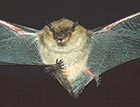Discovering bats in your country house
Arabella Youens discovers the bureaucracy surrounding bats in your property is pretty fearsome if you’re applying to make changes


Bats taking up residence in the rafters is becoming an increasing issue for country-house buyers and owners. As their natural habitats have gradually been lost, they have been forced to find alternative places to roost, and some species have adapted to living in all kinds of houses. The rules are simple: it's illegal to deliberately kill, injure, disturb or capture a bat, or intentionally or recklessly damage, destroy or obstruct access to a bat roost.
There are 17 species of bat breeding in the UK, but the most likely lodgers in period country houses are the long-eared variety, which prefers older buildings and usually roosts inside the roof void adjacent to the timbers, often along the ridge or beside the chimney breast.
For country-house owners, this only becomes a problem when applying for planning permission to extend or convert or at the point of selling. Bat-conservation groups maintain that having the creatures in your roof doesn't mean building work, repairs or timber treatment can't take place, but you will need to contact the local Statutory Nature Conservation Organisation (SNCO) for its advice before you proceed.
Typically, if bats are found in the areas affected by the planned works, then efforts need to be made to rehouse them. ‘But this can only be done at certain times of the year,' explains Philip Selway of The Buying Solution, which now includes a bat survey in due-diligence purchasing reports. ‘We're just coming to the end of the common nesting season.
The bats form maternity colonies and can't be disturbed at all.' This can spell trouble, as bats will often return to a maternity roost year after year, and these are protected whether bats are present or not.
Robin Gould of Prime Purchase describes the bureaucracy surrounding bats as ‘pretty fear-some. Not many people appreciate how troublesome bats can be. Where bats are present or there is evidence of their presence and any building works are planned, a specialist must be consulted.
All local authorities now have an expert and he or she will require a detailed statement of how the works will be carried out without any risk of disturbance to the bats. It's possible for a building programme to be completely stopped until a suitable approved schedule is in place. For example, a section of the roof might be cordoned off to protect the colony.'
Exquisite houses, the beauty of Nature, and how to get the most from your life, straight to your inbox.
At least two of Mr Selway's clients have had their plans delayed by the discovery of bats. ‘One house we were purchasing for a client needed a complete refurbishment, but the project was delayed by eight months when bats were discovered in the attic.'
At considerable cost, three ‘bat hotels' had to be provided in the gardens while the works were undertaken and special access tiles had to be installed on the new roof. ‘Once bats have been discovered at the house, Natural England are allowed to revisit at any stage to check on them. The most recent survey concluded that there were just three bats living in the roof and that all of the bat hotels had been taken over by blue tits and squirrels.'
Charles Birtles, who runs his own search company in Winchester, was forced to back down on a plot of land that he'd found for his clients to build on. A derelict bungalow had to be demolished first, but this wasn't permitted either during the breeding season or the winter hibernation season. ‘It left only three months in the year when the work could have been completed, which was hopeless.'
-
 You can’t always rely on the Great British summer — but you can rely on its watches
You can’t always rely on the Great British summer — but you can rely on its watchesBritish watchmakers have excelled themselves in recent months — releasing bright and beautiful timepieces that you'll want on your wrist through summer, and beyond.
By Chris Hall Published
-
 Simon Jenkins: 50 years of saving Britain's buildings, from triumphs and disasters to the great country house we bought for £1
Simon Jenkins: 50 years of saving Britain's buildings, from triumphs and disasters to the great country house we bought for £1In 1975, a new organisation was set up with the express aim of saving Britain's most beautiful and historic buildings from the wrecking ball. How has SAVE fared in the 50 years since then far? Simon Jenkins — who was involved as a trustee right from the very start — looks back on half a century of successes... and one or two painful failures.
By Simon Jenkins Published

